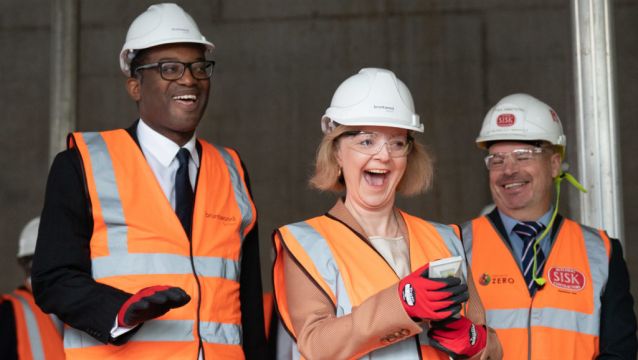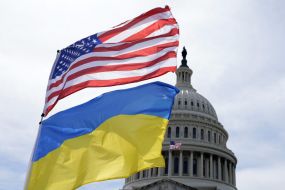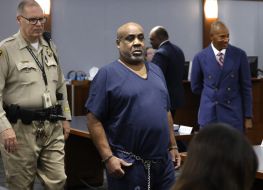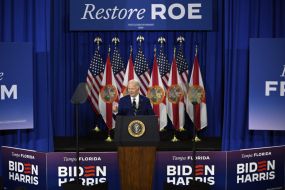Liz Truss entered Downing Street by promising Tory members she would turbocharge the economy with billions of pounds of unfunded tax cuts, in a tearing up of financial orthodoxy.
But faced with economic and political reality, she was humiliatingly dispatched by her MPs so quickly that she is now in the record books as the shortest-serving prime minister.
During her 44 full days in No 10, she oversaw the pound plummeting, the cost of government debt soaring and poll numbers skydiving before tearing up her “Trussenomics” plans.
Even by her standards for political identity changes, appointing former leadership rival Jeremy Hunt to replace her doomed old libertarian ally Kwasi Kwarteng as chancellor so he could trash her own economic vision was extraordinary.
Her authority was extinguished from that point and after battling to cling on to power, with chaotic scenes in the UK's House of Commons, she ultimately stood down on Thursday in the face of overwhelming pressure.
The earlier race to enter Downing Street was characterised by two competing economic visions: Ms Truss’s gung ho vision for going for growth no matter what compared to the fiscal caution of former chancellor Rishi Sunak, who warned her vision would end in catastrophe.
It was Ms Truss, presenting herself as an avid-Brexiteer, a free market-loving heir to Margaret Thatcher, who emerged as the clear favourite among activists if not MPs.
At the age of 47, Ms Truss took over the reins from scandal-battered Boris Johnson as the third female prime minister in the UK’s history.
Her victory was the final move in an extraordinary series of political transformations.
In her youth she marched side by side with left-wingers to demand the ousting of Mrs Thatcher and supported remaining in the European Union in the 2016 referendum.
The Conservatives were not even her first political party, having initially had a brush with the Liberal Democrats and using a speech at their 1994 conference to back a motion calling for the abolition of the British monarchy.
She was born in Oxford in 1975 to parents she describes as “left-wing”. Her mother, a nurse and a teacher, took a young Ms Truss to marches for the Campaign for Nuclear Disarmament in the 1980s and to a “peace camp”.
Aged four, she moved to Paisley in Scotland, where she has recalled yelling a slogan that perhaps no other Tory cabinet minister has ever yelled before.
“It was in Scottish, so it was ‘Maggie, Maggie, Maggie, oot, oot, oot’,” she has said.
But Ms Truss also had an early “fascination” with Mrs Thatcher, saying that she was around eight when she agreed to play her during a mock school election. “I got no votes,” she conceded.
Ms Truss says her father, a mathematics professor, has long struggled to comprehend her move to conservatism, believing, perhaps wishfully, she is a “sleeper working from inside to overthrow the regime”.
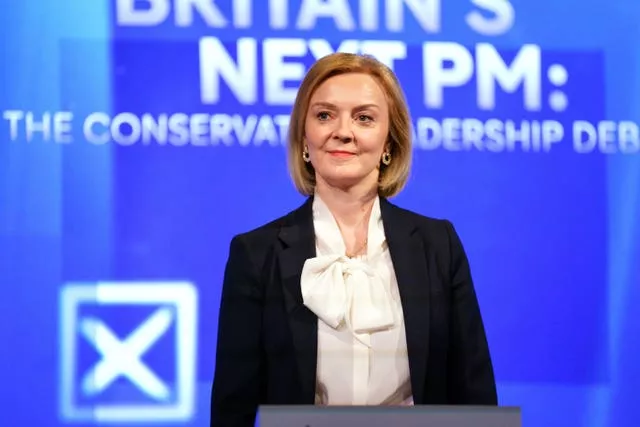
The family upped sticks to Leeds, where Ms Truss attended the Roundhay state secondary school before studying philosophy, politics and economics at Oxford University.
It was there that she became active in student politics, with the Liberal Democrats, and espoused the anti-monarchist sentiment.
“I think it was fair to say that, when I was in my youth, I was a professional controversialist and I liked exploring ideas and stirring things up,” she told the BBC’s Political Thinking With Nick Robinson.
At the 1997 Conservative Party conference, she met future husband Hugh O’Leary. She has two teenage daughters.

She entered parliament in the Tory safe seat of South West Norfolk after winning in the 2010 general election by a comfortable majority of more than 13,000 votes.
During her early days in parliament, she co-authored the Britannia Unchained book alongside Thatcherite future cabinet colleagues Mr Kwarteng, Priti Patel and Dominic Raab.
It set out proposals to strip back regulation and encourage innovation, but caused controversy with a claim that British workers are “among the worst idlers in the world”.
Two years after entering parliament, Ms Truss was part of the British government, being made an education minister in the Tory-Liberal Democrat coalition before being promoted to environment secretary in 2014.
But while her reputation as a political survivor was growing in Westminster, her image as a speechmaker faltered.
It was in the environment brief that she gave an often-ridiculed address to the Tory conference where she discussed her left-to-right conversion in a pantomime manner.

Her tone switched to a serious one when decrying the state of play that saw the UK importing two-thirds of its cheese. “That is a disgrace,” she insisted, deadpan.
Ms Truss’s star kept rising, however, and she did a year as justice secretary before heading to the British treasury as chief secretary and then leading the Department for International Trade.
It was during this period that her prolific and carefully curated social media output saw the department nicknamed the “Department for Instagramming Truss”.
Another political conversion was under way, and she shifted from arguing to stay in the EU at the 2016 referendum to become a strong defender of the decision to leave.
She was rewarded with the role of British foreign secretary, becoming only the UK’s second woman to hold the title, after Mr Raab was moved aside in the wake of his handling of the Afghanistan crisis.
In the Foreign Office she took a tough stance in talks and would anger the EU with legislation threatening to break international law over the Northern Ireland Protocol.

She would also oversee the successful release of Nazanin Zaghari-Ratcliffe and Anoosheh Ashoori from Iranian detention where other ministers had failed.
The Foreign Office gave her a much higher profile and she seized on it with numerous eye-catching photo ops that bore a resemblance to Mrs Thatcher’s escapades.
Though the frequent comparisons with the Tory grandee are at times derided as lazy and sexist, they are comparisons that Ms Truss has clearly sought to encourage.
Ms Truss donned military gear and perched in a tank for pictures during a visit to Estonia, echoing an image of Mrs Thatcher in a tank in West Germany in 1986.
Her choice of Russian hat on a visit to Moscow in February emulated that of Mrs Thatcher’s three decades earlier, while a leadership debate outfit also bore uncanny similarities.
But Mrs T lasted more than 11 years in office.
It was always going to be a challenge for Ms Truss, with her mandate coming only from the roughly 0.3 per cent of the UK population eligible to vote in the Tory membership contest.
An economic crisis was and still is threatening living standards, strikes are causing major disruption and a divided Tory party was already struggling in the polls after more than 12 years in government.
Ms Truss’s first weeks were muted. Two days after she entered office on September 6th the UK was plunged into a period of mourning by Britain's Queen Elizabeth II's death.
Her government oversaw Operation Bridges that led up to the former British monarch’s funeral as Ms Truss maintained a dignified quiet at a time when she wanted to overhaul the nation.
But not long after the mourning period ended, chaos reigned.
Doomed chancellor Mr Kwarteng detailed £45 billion of tax cuts, all without plans to fund them or official forecasts to assess their impact caused greater economic pain.
The pound plummeted to a fresh 37-year low as spooked traders came to grips with the cost of the spree.
An income tax cut for the highest earners was both politically toxic and unnerving for the markets.
Despite repeatedly insisting they would stand by their plan, Mr Kwarteng performed a dramatic mid-Conservative conference U-turn to scrap it.
He was ultimately sacked after 38 days in office to become the second-shortest chancellor in British history, as he failed to reassure the financial markets amid international warnings.
In a sign of desperation, Ms Truss brought in her old Tory leadership rival Mr Hunt on October 14th.
He swiftly tore her economic vision to shreds, criticising the “mistakes” of Ms Truss’s leadership, leaving many thinking she was now PM in name only.
Days later he scrapped “almost all” the tax cuts Ms Truss’s tax cuts in an emergency statement to the House of Commons.
At that point it was clear the PM was mortally wounded, but many thought she would struggle on until the scheduled medium-term fiscal strategy due on Halloween.
But the horror show would only worsen.
On the day she declared she is “a fighter, not a quitter”, she was writing her own demise.
Suella Braverman was pushed to resign as home secretary over a breach of the ministerial code, but this came after the pair had engaged in an almighty row.
A darling of the Tory right, Ms Braverman left with a scathing assessment on the “tumultuous” Truss administration.
Then the PM botched what should have been a tricky, but not life-support-inducing, Labour motion seeking to ban fracking, one of the Tory manifesto promises she was tearing up.
The Conservative whips ordered MPs to back the government, warning it was a “confidence motion” in her leadership, one she would clearly win.
The chaos in which they handled it, flip-flopping on orders and then allegedly bullying colleagues to vote against the opposition motion in the Commons, made things worse.
Witnesses say chief whip Wendy Morton in fact resigned during the tumult, before Downing Street sent a 1.33am message insisting she was still in post.
The infighting, the ugly scenes and the desperate attempts to insist the circus still had a ringleader further angered MPs.
A steady stream of Conservatives broke rank to publicly demand her exit, with the number more than doubling to 15 before lunch was over.
Sir Graham Brady, the chairman of the 1922 Committee of backbench Tories, was summoned to No 10 by Ms Truss for discussions on the Conservative mood.
Exactly what he conveyed was unknown, but the writing was clearly on the wall because the podium was pushed out onto Downing Street and a statement scheduled for 1.30pm.
Accompanied onto the street by her husband, Ms Truss announced her resignation, saying she “cannot deliver the mandate” given to her by Tory members.
She said another leadership election will produce a new Conservative prime minister “within the next week”.
Ms Truss enters the history books as the shortest lived PM. She holds that title by a number of months, with second placed George Canning on 118 days before he died in office in 1827.
Her demise leaves behind a political vacuum. It could be filled by Mr Sunak, who will no doubt argue he was right all along on the economy.
But there could also be a dramatic comeback for Mr Johnson, six weeks after he was forced from office after a series of scandals, not least partygate.
Whoever takes the chalice, there will no doubt be a lingering taste of poison.
The Tory polls are at rock bottom and Labour on the resurgence as the Conservatives look for the third change of leadership on the mandate they won back in 2019.
